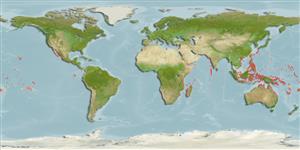Teleostei (teleosts) >
Ophidiiformes (Cusk eels) >
Carapidae (Pearlfishes) > Carapinae
Etymology: Encheliophis: Greek, enchelys, = eel + Greek, ophis = serpent (Ref. 45335).
Environment: milieu / climate zone / depth range / distribution range
Ecology
Marine; reef-associated; depth range 0 - 1 m (Ref. 58018). Tropical; 30°N - 28°S
Indo-Pacific: Gulf of Aden to the Philippines and the Society Islands, north to the Ryukyus. Range extends to the eastern Pacific.
Size / Weight / Age
Maturity: Lm ? range ? - ? cm
Max length : 13.0 cm TL male/unsexed; (Ref. 90102)
Dorsal soft rays (total): 19 - 27; Anal soft rays: 36 - 43. Eel-like, moderate to shallow body depth; maxilla adnate or nearly so; cardiform teeth present; branchiostegal membranes partly or completely united; swim bladder with thin terminal membrane or bulb; lacking enlarged dentary or premaxillary fangs, dentary diastema, pelvic fins, and swim bladder rocker bone (Ref. 34024). Lacks externally visible pectoral fins (Ref. 51068).
A benthic species which occurs in inshore waters and inhabits coral reefs (Ref. 75154). Uncommon species (Ref. 34024). Holothurian parasite with male-female pairs in each host (Ref. 34024, 75154). Associated with holothurians including Holothuria leucospilota, H.scabra, H.lubrica, and Thelenota ananas (Ref 90102).
Life cycle and mating behavior
Maturity | Reproduction | Spawning | Eggs | Fecundity | Larvae
Nielsen, J.G., D.M. Cohen, D.F. Markle and C.R. Robins, 1999. Ophidiiform fishes of the world (Order Ophidiiformes). An annotated and illustrated catalogue of pearlfishes, cusk-eels, brotulas and other ophidiiform fishes known to date. FAO Fish. Synop. 125(18):178p. Rome: FAO. (Ref. 34024)
IUCN Red List Status (Ref. 130435: Version 2024-1)
Threat to humans
Harmless
Human uses
Fisheries: of no interest
Tools
Special reports
Download XML
Internet sources
Estimates based on models
Preferred temperature (Ref.
123201): 24.9 - 29.3, mean 28.4 °C (based on 2331 cells).
Phylogenetic diversity index (Ref.
82804): PD
50 = 0.5078 [Uniqueness, from 0.5 = low to 2.0 = high].
Bayesian length-weight: a=0.00102 (0.00046 - 0.00225), b=3.06 (2.88 - 3.24), in cm total length, based on all LWR estimates for this body shape (Ref.
93245).
Trophic level (Ref.
69278): 3.3 ±0.3 se; based on size and trophs of closest relatives
Fishing Vulnerability (Ref.
59153): Low vulnerability (10 of 100).
